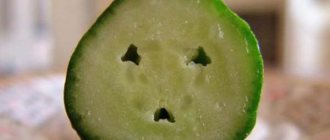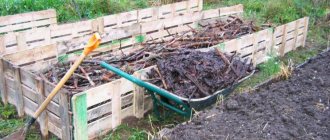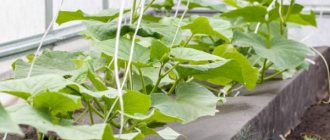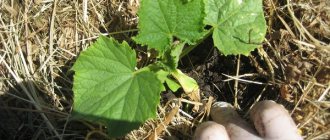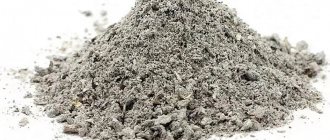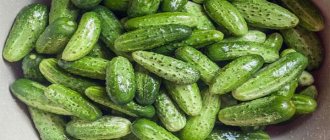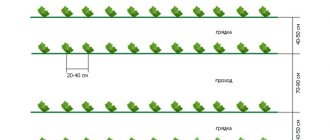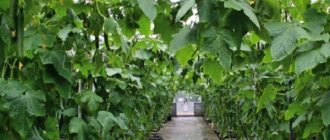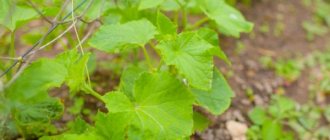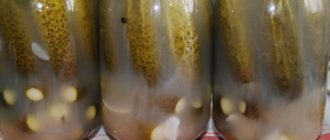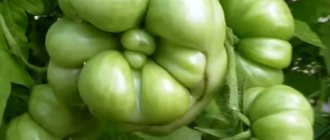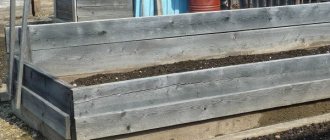Potassium deficiency
The most common and, at the same time, the most banal reason for the curvature of the fetal shape. Why does this error occur so often? Most likely, because in the second half of summer, gardeners feed cucumbers with herbal infusions, manure and other nitrogen-containing substances, and forget about potassium fertilizer. The doses of fertilizer that were applied in the fall and during planting are exhausted by the end of the second month of summer, and the plants begin to starve. This is why the shape of the fruit is disrupted. Another important point: the rules for potassium nutrition in August and September differ significantly from those that are suitable for the beginning of summer. During these months the weather changes. It gets cool outside, so fertilizers are less absorbed. The way out of the situation is simple: use ash. It needs to be placed directly under the root, and then the plant will receive the necessary amount of nutrients.
Why they grow with crochets: reasons
Curvature and deformation of cucumber fruits may indicate several reasons for this defect. The reason for changing the shape of cucumbers may be insufficient soil fertility, lack of moisture or sunlight, untimely fertilizing, sudden changes in air temperature, a large difference between night and day temperatures, untimely removal of fruits from the bushes that have reached a standard size, and under-pollination of the ovaries.
All these factors indicate that during planting seedlings and caring for cucumber bushes, deviations were made from the agricultural technology of growing the vegetable. The appearance of deformed, hook-shaped cucumbers is usually caused not by a single violation, but by a combination of them.
Temperature reduction
As mentioned earlier, in late summer and early autumn the average air temperature drops significantly. It gets chilly at night. For a cucumber that came to our country from the tropical forests of India, such conditions are unacceptable. To ensure that the plants bear fruit fully, cover them with film. To make it warmer, you can put several bottles of hot water. They will maintain the temperature. If we are talking about a greenhouse, organize electric heating.
Growing bee-pollinated and parthenocarpic cucumber varieties in one greenhouse
This should not be done, since bees also visit varieties that do not require pollination. Plant them in different greenhouses, and there will be no problems. If there is only one greenhouse, divide it into two parts. For this you can use gauze or any non-woven material.
Advice from gardeners
Recommendations for solving problems with the appearance of cucumbers:
- compliance with crop rotation;
- proper arrangement of seedlings, taking into account all previous predecessors;
- sowing of cucumbers should be carried out taking into account the requirements of specific varieties and species;
- mandatory mulching and loosening of the soil at the initial stage of planting. The soil around the plant cannot be loosened, since the cucumber has a superficial root system;
- It is allowed to use only warm, settled water for irrigation;
- You can protect bushes when temperatures drop using covering materials. Agrofibre will not only retain heat, but also protect the crop from all kinds of diseases. The shelter must be regularly opened and ventilated;
- timely fertilizing with wood ash or potassium will help to obtain an even and high-quality harvest;
- It is important to collect fruits at least 3 times a week. Reducing the load on the bush will allow the plant to evenly distribute the necessary nutrition.
With constant monitoring and timely care, the harvest will turn out beautiful and will have the correct shape. Following simple rules will prevent visual changes in cucumbers. It is important to pinch young shoots in a timely manner, to prevent the plantings from becoming too dense, and to control the lighting and soil moisture level.
How to grow fruits of the correct shape?
To make cucumbers look like themselves, follow simple rules:
- watering: only warm water, and only at temperatures above 20 degrees;
- lighting: minimum direct sunlight. During the daytime, plants should be protected from ultraviolet radiation;
- nutrition: all essential substances must be in harmony. Plants that are deficient in one or another element bear fruit of poor quality.
As for pest control, try to use gentle, natural-based products. Otherwise, the fruits will be no different from those that are overfed with chemicals in large fields.
Why are cucumbers irregularly shaped?
There is no clear answer as to why cucumbers grow with crochets in greenhouse conditions. The fact is that such a deviation can occur for various reasons. Here are examples of the most common factors that cause a cucumber to acquire an irregular, hooked appearance, and how to eliminate them.
Poor nutrition
Cucumbers are a fastidious crop that needs additional nutrition. Without the required amount of nutrients, the fruits of the vegetable begin to become deformed, and the foliage of the plants begins to turn yellow. But, at the same time, an excess of nutrients has a negative impact on productivity.
Therefore, when growing cucumbers, it is important to take into account the concentration of fertilizers, the time and methods of their application.
Potassium fasting
Potassium is one of the most important microelements for cucumbers. Due to it, the movement of juices and the development of plants occurs. In addition, it is involved in the formation of fruits.
With potassium starvation, the cucumber becomes pear-shaped. It usually has a narrow “butt” and a spherical tip. In addition, with a lack of potassium, cucumbers develop a bitter taste, which can ruin any dish with just one ingredient.
You can increase potassium in the soil with fertilizers such as:
- wood ash;
- Calimagnesia;
To obtain an infusion from ash, use 1-2 liters of fireproof wood residues and 15 liters of water. After standing for several days, the resulting concentrate is diluted with 1 bucket of water and 0.5 liters are added per bush.
Potassium magnesium is used in dry form, at the rate of 20 grams of powder per 1 square meter. These fertilizers are used as root fertilizers. The optimal time for application is considered to be the flowering stage and fruit formation.
Nitrogen starvation
Nitrogen-containing components for cucumbers are important at all stages of their growth. Lack of nitrogen negatively affects the growth of green mass, flowering and fruiting of plants. However, when there is an excess of it, cucumber fruits begin to curl and take on a hooked appearance. In order to saturate the soil with the required amount of nitrogen, experienced gardeners advise using the traditional method with chicken droppings. It is used for cucumbers in liquid form.
Scheme for preparing the solution:
- Chicken manure is diluted with water in a ratio of 50:50.
- The concentrated mixture is infused for 3 days.
- After the specified time, the solution is diluted with water in a ratio of 1:10.
See also
How to prepare the soil for cucumbers in the spring in a greenhouse and what kind of soil they like
Read
The resulting concentrate is introduced into the soil, at the roots of the plants.
Neglect of crop rotation rules
Curling of cucumbers also occurs with improper rotation of growing vegetable crops in a greenhouse. The fact is that improper crop rotation leads to a violation of the mineral balance of the soil and its fatigue. Therefore, in order for cucumbers to have an attractive appearance, they must be alternated annually with other plants. The optimal option for crop rotation is the replacement of “roots-tops”. With this approach, vegetables will also stop tasting bitter.
Unsuitable varieties
In the case when the cultivation of several varieties of vegetable crops involves open or closed ground, you need to take into account what variety they belong to.
There are two categories of cucumbers, these are:
- hybrids;
- parthenocarpic.
In the first variety, the fruit ovary is formed without pollination. Parthenocarpic varieties bear fruit only with the participation of pollinating insects. If the flowers of these plants are located next to each other, cross-pollination occurs. In most cases, this process leads to disruption of plant growth, and their fruits begin to curl.
Wrong neighborhood
Edible and familiar representatives of vegetable crops can be a threat to cucumbers. The fact is that an illiterate combination of plants in greenhouse structures leads to root and leaf specific secretions that contribute to allelopathy.
Thus, the following are considered depressing neighbors for cucumbers:
- potato;
- tomatoes;
- spices;
- green salads.
It is not advisable to place cucumbers next to plants that will shade them. With a lack of light, vegetable fruits accumulate small amounts of sugar and other nutrients.
Violation of the rules of care
Agrotechnical work plays a big role when growing cucumbers. At the same time, they are not labor-intensive and do not take up a lot of free time. However, agricultural technology requires compliance with certain rules.
Sudden temperature changes
Cucumbers are fairly heat-loving plants that begin to curl up in extreme cold and temperature changes. The optimal thermal range for the crop is considered to be +14.5, +42 degrees. The daytime temperature, which increases the marketable characteristics of the fruit, is +25, +30 degrees, the night temperature is +15, +20 degrees.
If the thermal range decreases, seedlings and adult cucumbers are covered with additional film to avoid freezing. In cases where the air temperature goes beyond high limits, greenhouses need to be ventilated.
Improper irrigation organization
Vegetable crops respond negatively to improper watering. Inappropriate irrigation organization leads to various diseases, due to which the fruits begin to grow crooked. Rules for irrigating cucumbers in greenhouse conditions:
- Watering should be done carefully, right to the roots of the plants, without eroding the soil or breaking the stems. Therefore, as a watering attribute, it is better to choose a garden watering can rather than a hose.
- Water for irrigation should be warm, within +18, +23 degrees. Under no circumstances should it be below 10 degrees. Otherwise, the cucumbers will not only stop growing, but also die.
- In dry summers, as well as on light sandy soils, plants are irrigated several times a week.
- In a humid climate and on soil that retains water well, watering is carried out less frequently, but more abundantly.
- To avoid burns of foliage from sunlight when moisture gets in, it is better to irrigate in the morning or evening hours.
- It is recommended to ventilate the greenhouse before sprinkling. If frosts are expected at night, it is better to postpone irrigation to the morning.
- The water norm for young plants is considered to be 5-10 liters per 1 square meter. During fruiting, this figure increases to 15-20 liters.
See also
Description of the Paratunka F1 cucumber variety, cultivation characteristics and yield
Read
The given values are not critical. They may vary depending on the hook-shaped type of fruit and plant variety.
Advice! Some varieties and hybrids of cucumbers have individual water requirements. Therefore, when purchasing this or that vegetable crop, you should read the attached growing instructions. As a rule, it is indicated on the seed packaging.
Late harvest
In the case where gardeners follow all the growing rules, but the cucumbers still look crooked, you need to pay attention to how the harvest is carried out. If fruits are not picked in a timely manner, a large number of overgrowths will form on the bushes. Despite the fact that these giants are no longer edible, they continue to absorb nutrients. As a result, young cucumbers do not receive enough useful microelements and begin to curl up. To avoid this, experienced gardeners advise harvesting every 2-3 days.
No change of place
This is the primary cause of problems with cucumbers. According to the rules of crop rotation, it is not recommended to plant cucumber seedlings in the same place for two years in a row.
In the second year after planting, colins accumulate in the ground. These substances have an extremely negative effect on the appearance of the fruit.
Do not plant cucumbers after such demanding and “gluttonous” crops as potatoes. Its powerful tubers literally pull out all the nutrients from the soil, completely dehydrating it within a season. By next spring, such soil does not have time to recover. Carrots, legumes and cabbage are suitable as predecessors.
When and what to feed cucumbers
Cucumbers, like other crops, need to be fed periodically. Mineral and organic foliar and root applications of nutrients are suitable.
It is recommended to apply fertilizers and growth stimulants at least four times:
- The first feeding is carried out two weeks after planting the seedlings in a permanent place. From organic matter, you can use chicken droppings, manure or herbal infusion. It is better to choose Ammophos from mineral supplements.
- The second feeding coincides with mass flowering. Superphosphate, boric acid, and wood ash are used.
- The next feeding is carried out during the period of active fruit formation. Potassium nitrate, urea, and wood ash are suitable.
- After the first harvest, the last application of fertilizing is carried out to increase the duration of fruiting and the quality of the crop.
Improper watering can cause cucumbers to grow crooked
Please note that the curvature of the cucumber’s body can be affected by both lack of moisture and watering with cold water.
The cucumber vine produces wide leaves. If there is a lack of moisture, the fruits do not receive enough juice and grow underdeveloped and may even bend into a ring. Approximately the same results from watering with cold water; when forming the body of a cucumber, the absorption of potassium from the soil is important; a decrease in soil temperature from cold water blocks the absorption of this microelement by the roots.
When and what to feed cucumbers
Cucumbers, like other crops, need to be fed periodically. Mineral and organic foliar and root applications of nutrients are suitable.
- The first feeding is carried out two weeks after planting the seedlings in a permanent place. From organic matter, you can use chicken droppings, manure or herbal infusion. It is better to choose Ammophos from mineral supplements.
- The second feeding coincides with mass flowering. Superphosphate, boric acid, and wood ash are used.
- The next feeding is carried out during the period of active fruit formation. Potassium nitrate, urea, and wood ash are suitable.
- After the first harvest, the last application of fertilizing is carried out to increase the duration of fruiting and the quality of the crop.
Dense plantings
If the bushes are planted too densely, this leads to poor air circulation. Plants receive little sunlight, which is especially important at the stage of formation of the first ovaries.
A lack of light and oxygen will provoke the development of pathogenic fungi, various diseases and the proliferation of pests.
Under the influence of these factors, cucumbers grow of irregular shape and size. The situation can be corrected by installing trellises.
- Author: Zimina Tatyana
Rate this article:
- 5
- 4
- 3
- 2
- 1
(2 votes, average: 4.5 out of 5)
Share with your friends!
Why do cucumber seedlings wither?
Many people, especially novice gardeners, wonder why cucumber seedlings turn yellow and dry out when agricultural cultivation practices are fully observed. The most common cause is an attack by pests parasitizing the plant.
These include spider mites and melon aphids. Both parasites damage the leaves, sucking out the juices necessary for the development of the plant. And this leads to the appearance of yellow spots and drying of the leaves.
melon aphid
Plant damage can be determined visually by the changed color and shape of the leaves of the seedlings. The appearance of “honeydew” is noticeable on the leaves - this is the secretion of pests. These secretions are an excellent breeding ground for fungi.
It is necessary to inspect the seedlings to identify the pest. If aphids appear, treatment with Decis or Inta-vir will help, strictly following the instructions on the packaging of the insecticide. Read more about aphid control.
Spider mite
The pest specimens are so small that upon examination it is impossible to determine the mite infestation. It is determined when the leaves show signs of wilting. With a severe degree of damage, whitish spots are visible, on the surface of which a coating of cobwebs can be seen.
A measure to combat spider mites is treatment with drugs - insecticides such as Iskra M, Actellik.
When and what to feed cucumbers
An important point in the process of growing cucumber crops is the application of fertilizers and growth stimulants.
It is important to know when, in what quantity and what element is best to apply. At different periods of development, a culture needs certain microelements to a greater or lesser extent.
The first feeding is carried out after the third true leaf unfolds. Nitrogen is necessary for the growth of green mass. At this time, choose urea, nitrophoska or mullein infusion with potassium sulfate.
The next feeding occurs during the flowering period. The plant needs potassium most of all. Foliar or root feeding with compositions containing wood ash is suitable. Mullein infusion with superphosphate and potassium sulfate saturates the soil well. Nitrogen, magnesium and potassium are necessary during the period of active fruiting. It is useful to apply potassium nitrate using the foliar method.
Incorrect implementation of scheduled fertilizing
Excess nitrogen and phosphorus in the soil leads to the fall of the ovaries.
Another reason for the distorted body shape of a cucumber occurs due to a lack of potassium. It is incorrect to say that potassium deficiency can be corrected by foliar feeding. This will likely lead to an even greater mineral imbalance. This especially applies to nitrogen and potassium fertilizers. As a result, the shape of the cucumber becomes even more distorted.
It is best to restore soil balance during pre-sowing treatment by applying organic fertilizers or observing crop rotation. At the same time, an excess of nitrogenous fertilizers in the soil against the background of a lack of potassium and phosphorus fertilizers can lead to wilting of the ovaries.
Late harvest
An untimely harvest of cucumbers can also affect further changes in the shape of future fruits. The overgrowths present on the cucumber vine not only lose their taste characteristics, but also inhibit the further development of young vegetables, disrupting the supply of adequate mineral nutrition to them, resulting in a completely different shape from what a classic cucumber should have.
It is recommended to harvest cucumbers at least once a day in order to provide young green plants with the opportunity to eat.
In cases where it is not possible to maintain the cucumber harvest with the proper frequency, experienced gardeners recommend harvesting vegetables at least once every 2-3 days, all at once - from fully ripe ones to small gherkins that have grown up to 4 cm. At the same time, when harvesting a cucumber harvest, it is worth paying attention to the quality of cucumber lashes:
- it is important that they do not get upset and rot,
- old ones that have begun to dry out should be removed,
- Greens with signs of pathology and disease are not left behind.
Parasites and diseases
The leaves turn yellow and wrinkle due to the presence of fungal diseases. The most common disease of cucumbers is powdery mildew. White or yellow spots with a coating similar to flour appear on the foliage. The next stage in the development of the disease is the curling of the petals inward. To get rid of powdery mildew, you cannot do without chemicals. Medications with a high copper content help best. Substance:
- disinfects bacteria and microbes;
- evens out the color of foliage;
- relieves the disease.
Another disease that cucumbers are susceptible to is anthracnose. It appears as large yellow-brown spots over the entire leaf area. The disease progresses rapidly, covering a large area. Without the necessary treatment, anthracnose destroys the entire vegetative system of the plant, which means it almost certainly leads to death. To combat, use a 1% solution of colloidal sulfur. Apply at the root and spray directly onto the infected areas. The main thing is to do this not under the scorching sun.
Sulfur is used 3-4 times per season. For the fixing effect, treatment is carried out with copper sulfate. It completely extinguishes foci of infection and restores normal plant function.
Downy mildew manifests itself as complete drying of the leaves and round yellow spots over the entire area of the plant on the reverse side. After plaque is detected, watering is stopped for a week. After this period, the presence of previous plaque is checked. If it persists, the active phase of treatment begins.
Advice! It is optimal to use the drug Oxychom. It is diluted in an amount of 23 g per bucket of water.
If there are more than four weeks left before the expected fruiting, the drug Rizoplan is used as an additional remedy. Two tablespoons of the product are diluted in a bucket of water. After using the drug, the harvest can be harvested no earlier than a month later. It is optimal to use the product in the spring, when the first shoots have just appeared. At the same time, after such treatment it is possible to grow cucumbers again in this area only after 3-4 years
It is important to carefully remove all tops from the area
There are many common pests among cucumber plants:
- aphid;
- spider mite
Any pest can be easily identified by looking at the inside of the leaf. A plant infected with pests blooms more slowly, and all the juices drain from such a bush. Chemicals are used to combat them. The best insecticides for controlling aphids and spider mites:
- Metaphos;
- Hyphen;
- Karbofos;
- Kinmiks.
Attention! Their use is possible even before flowering. At the budding stage, insects can be controlled only with natural preparations.
Ignorance of the variety and rules for planting cucumbers
Why do cucumbers grow with crochets, even if we did everything right? Planting seeds and incorrect selection of varieties can be of great importance in the development and formation of the shape of the fruit. Even if everything was done strictly according to agricultural technology, the planting schedule and agricultural processing technology were followed, but the fruits still grow in an irregular shape.
A more detailed analysis reveals that not everything was carried out according to the rules of agricultural technology, for example: varieties such as bee-pollinated (bee-pollinated) and self-pollinating (parthenocarpic) varieties were planted nearby, as a result, cross-pollination of varieties causes the growth of genetically incorrectly formed fruits.
Methods for restoring cucumber leaves
So, we have looked at various reasons for the appearance of yellow and drying leaves on cucumber plants, but sometimes it happens that none of these reasons are suitable, then you can use universal methods of restoring the normal appearance of leaf blades.
The most reliable method is to treat cucumbers with compounds that can simultaneously fight pests and enrich the plants with minerals.
Option one: a mixture of milk and soap. It is necessary to add a liter of milk, 30 g of laundry soap and 40 drops of iodine to a bucket of water
It is important to stir the soap very well until it is completely dissolved; it will act as an “adhesive.” Cucumbers should be treated with this solution as soon as the first yellow leaves appear and do so every two weeks until they disappear
Option two: infusion of bread and iodine. It is necessary to soak a whole loaf of rye bread in a bucket of water for 15-20 hours, after which you should add 60-70 drops of iodine to the solution, strain and you can treat cucumbers with this infusion every 12-14 days.
Option three: infusion of onion peels. You need to take 500-600 grams of onion peel and add a bucket of water. This container needs to be brought to a boil, then removed from the heat, closed with a tight lid and left for 12-15 hours. All that remains is to strain, dilute by half with water and you can either treat the plants or water them under the bush, spending 250-300 g for each.
